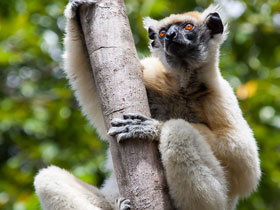The golden-crowned sifaka or Tattersall's sifaka (Propithecus tattersalli)
The golden-crowned sifaka or Tattersall's sifaka (Propithecus tattersalli) is a medium-sized lemur characterized by mostly white fur, prominent furry ears, and a golden-orange crown.
Appearance
Propithecus tattersalli is a primate of the family Indriidae.
Propithecus tattersalli is the smallest member of the genus. It has a body length of 45 to 47 cm and a tail length of 42 to 47 cm and a weight of 3.4 to 3.6 kg. The coat colour of Propithecus tattersalli is predominantly white, with a characteristic yellow-orange tip on the head. A similar shade is sometimes found on the shoulders, upper limbs and chest. The hairless face is black and the eyes are orange. Also characteristic are the white "tassels" on the ears.
Distribution
Propithecus tattersalli, like all lemurs, only inhabits Madagascar. A small mountain range is found in the north of the island, between the Loky and Manambato rivers. The animals live in dry deciduous forests below 500 m above sea level.
Lifestyle and feeding habits
These primates are mostly active during the day, with occasional activity before dawn and at dusk during the rainy season. At night they sleep in the treetops. Most of the time they stay in the trees, crawling or jumping.
They live in groups of three to ten individuals (most often 5-6), consisting of several males, several females and their young together. Group members communicate using a large number of sounds, having in their arsenal sound signals of danger from predatory birds and ground predators.
The size of the plots varies from 6 to 12 hectares and the length of the daily walk ranges from 400 to 1200 m. During the dry season, the distance increases due to the reduced food range.
They are herbivores and feed on young vegetables, immature fruits, seeds, shoots and flowers.
Reproduction
After a gestation period of 170 days, the female gives birth to a single young in July. It clings to its mother's belly and then climbs onto her back. At five months of age, it is weaned from its mother. Every two years, the female gives birth to a litter.
Conservation status
The area of distribution is less than 5000 km². Uprooting of trees, fires and mining reduce habitats. Hunting also affects the population, which ranges from 6,000 to 10,000 individuals. The IUCN classifies the species as endangered.

















































